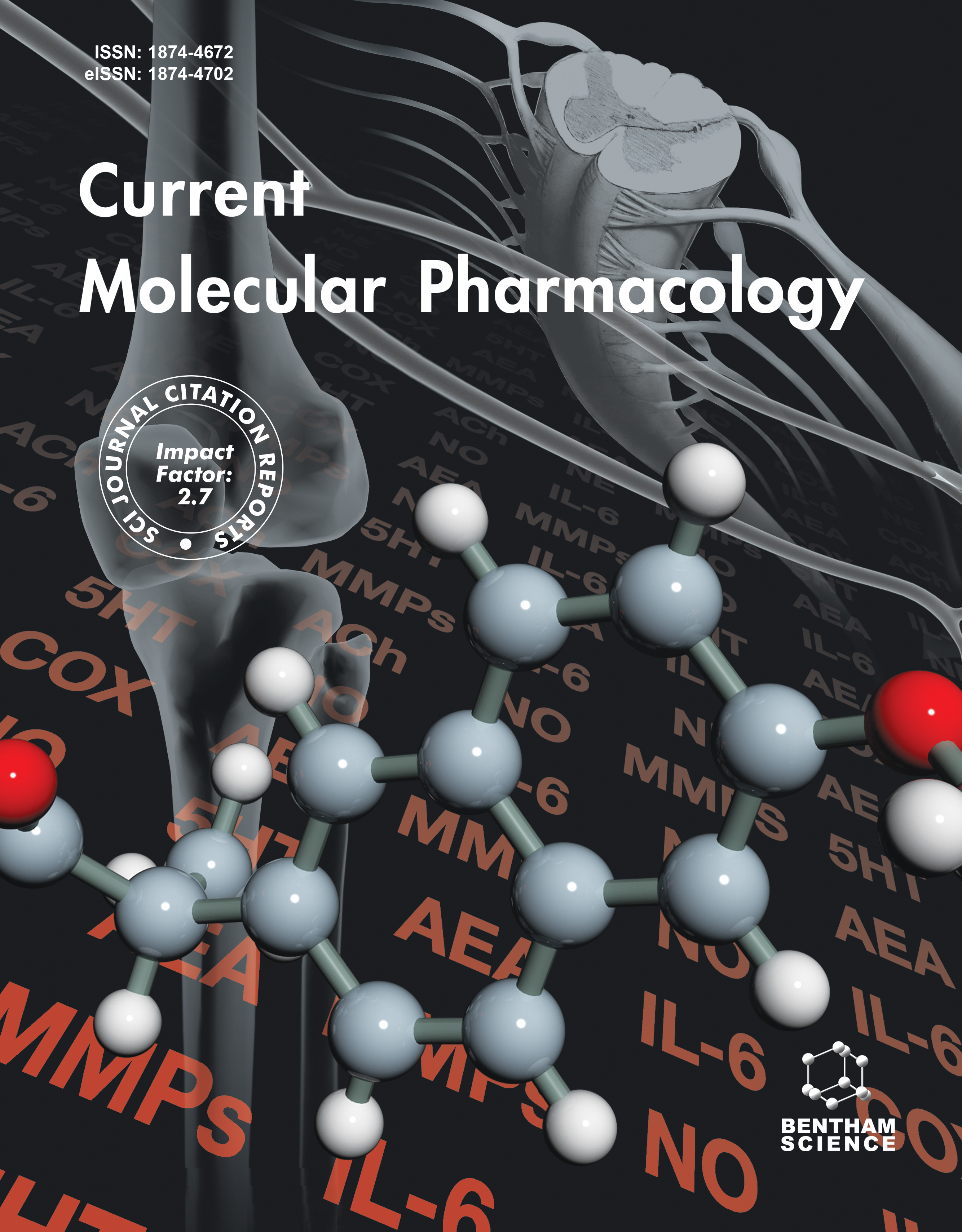- Home
- A-Z Publications
- Current Molecular Pharmacology
- Previous Issues
- Volume 10, Issue 3, 2017
Current Molecular Pharmacology - Volume 10, Issue 3, 2017
Volume 10, Issue 3, 2017
-
-
Alcoholic Liver Disease: from CYP2E1 to CYP2A5
More LessAuthors: Tung Ming Leung and Yongke LuThis article reviews recent studies on CYP2E1-mediated alcoholic liver injury, the induction of CYP2A5 by alcohol and the mechanism for this upregulation, especially the permissive role of CYP2E1 in the induction of CYP2A5 by alcohol and the CYP2E1-ROS-Nrf2 pathway, and protective effects of CYP2A5 against ethanol-induced oxidative liver injury. Ethanol can induce CYP2E1, an active generator of reactive oxygen spe Read More
-
-
-
Role of Early Growth Response-1 in the Development of Alcohol-Induced Steatosis
More LessAuthors: Paul G. Thomes and Terrence M. Donohue, Jr.Here, we describe research on the involvement of the transcription factor, Early Growth Response- 1 (Egr-1) in alcohol-induced liver injury, specifically, fatty liver (steatosis), one of the earliest and most frequent signs of liver injury that occurs after heavy drinking. Egr-1 is a ubiquitous transcription factor found in nearly all cell types. However, because the liver is the principal site of ethanol oxidation, it sustains the grea Read More
-
-
-
Role of the Wnt/β-Catenin Pathway in the Pathogenesis of Alcoholic Liver Disease
More LessAuthors: Jaideep Behari and Karl G. SylvesterThe Wnt pathway is a highly conserved signal transduction pathway that plays an important role in diverse aspects of hepatic physiology. The Wnt pathway, consisting of canonical and noncanonical arms, is composed of secreted glycoproteins, cell surface receptors and co-receptors, and complex intracellular regulatory machinery that regulate a large number of cellular functions.β-Catenin is the main effector of the cano Read More
-
-
-
The Hepatic Lipidome: A Gateway to Understanding the Pathogenes is of Alcohol-Induced Fatty Liver
More LessAuthors: Robin D. Clugston, Madeleine A. Gao and William S. BlanerChronic alcohol consumption can lead to the development of alcoholic fatty liver disease. The underlying pathogenic mechanisms however, have not been fully elucidated. Here, we review the current state of the art regarding the application of lipidomics to study alcohol's effect on hepatic lipids. It is clear that alcohol has a profound effect on the hepatic lipidome, with documented changes in the major lipid categories (i.e. f Read More
-
-
-
Role of CYP2E1 in Mitochondrial Dysfunction and Hepatic Injury by Alcohol and Non-Alcoholic Substances
More LessAuthors: Mohamed A. Abdelmegeed, Seung-Kwon Ha, Youngshim Choi, Mohammed Akbar and Byoung-Joon SongAlcoholic fatty liver disease (AFLD) and non-alcoholic fatty liver disease (NAFLD) are two pathological conditions that are spreading worldwide. Both conditions are remarkably similar with regard to the pathophysiological mechanism and progression despite different causes. Oxidative stressinduced mitochondrial dysfunction through post-translational protein modifications and/or mitochondrial DNA damage has been a Read More
-
-
-
Signal Transduction Mechanisms of Alcoholic Fatty Liver Disease: Emer ging Role of Lipin-1
More LessAuthors: Min You, Alvin Jogasuria, Kwangwon Lee, Jiashin Wu, Yanqiao Zhang, Yoon Kwang Lee and Prabodh SadanaLipin-1, a mammalian phosphatidic acid phosphatase (PAP), is a bi-functional molecule involved in various signaling pathways via its function as a PAP enzyme in the triglyceride synthesis pathway and in the nucleus as a transcriptional co-regulator. In the liver, lipin-1 is known to play a vital role in controlling the lipid metabolism and inflammation process at multiple regulatory levels. Alcoholic fatty liver disease (AFLD) is one of th Read More
-
-
-
Structure, Function and Metabolism of Hepatic and Adipose Tissue Lipid Droplets: Implications in Alcoholic Liver Disease
More LessFor more than 30 years, lipid droplets (LDs) were considered as an inert bag of lipid for storage of energy-rich fat molecules. Following a paradigm shift almost a decade ago, LDs are presently considered an active subcellular organelle especially designed for assembling, storing and subsequently supplying lipids for generating energy and membrane synthesis (and in the case of hepatocytes for VLDL secretion). LDs al Read More
-
-
-
Review: Precision Cut Liver Slices for the Evaluation of Fatty Liver and Fibrosis
More LessIntroduction: Ethanol metabolism in the liver results in oxidative stress, altered cytokine production and fat accumulation in the liver. Thus, it is thought that the accumulation of benign fat into the liver in conjunction with a “second hit” leads to liver failure. However, we have recently developed the use of precision-cut liver slices (PCLSs) as an in vitro culture model in which to investigate the pathophysiology of alcohol- Read More
-
Most Read This Month
Article
content/journals/cmp
Journal
10
5
false
en


